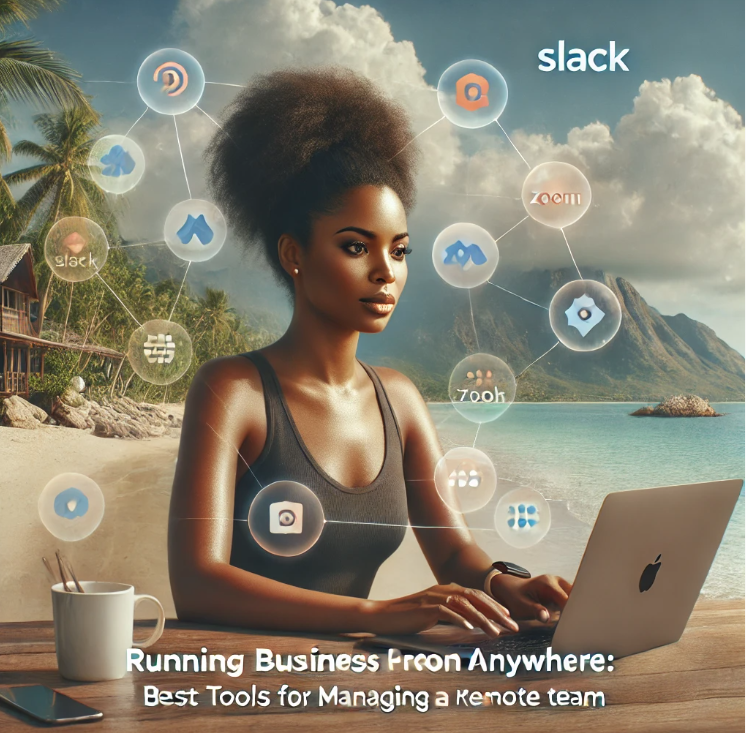The Rise of the Remote Work Era
From Cubicles to Couches: How the Workplace Evolved
Once upon a time, business attire meant suits and ties, and productivity was measured by how early you arrived and how late you stayed. Then came the internet, laptops, cloud computing—and eventually, a global pandemic that threw traditional office norms into a blender.
Remote work didn’t just become viable; it became necessary. Companies pivoted, employees adapted, and suddenly, commutes were replaced with coffee strolls from the kitchen to the living room. The shift was seismic. According to a Gallup poll, 8 in 10 people now work hybrid or fully remote. That’s not just a trend—it’s a transformation.
Remote work means lower overheads, access to a global talent pool, and often, happier employees. But it also means rethinking everything—from how we communicate to how we lead. And that’s where the right tools come in.
Why Remote Is More Than a Trend—It’s the New Norm
Let’s be real: the idea that everyone will eventually return to the office full-time is about as outdated as dial-up internet. With technology powering global connectivity, businesses can now function without a physical address—often more efficiently than they did before.
Not convinced? Major companies like GitLab, Zapier, and Automattic (hello, WordPress!) run entirely remotely—and they’re crushing it. They’ve proven that with the right digital stack, physical proximity isn’t a prerequisite for success.
Plus, employees have gotten a taste of the good life. No commute. Greater flexibility. Better work-life balance. It’s no surprise that 97% of workers now prefer remote or hybrid setups. If you’re a business owner, this is your cue to lean in—or get left behind.
Challenges of Managing a Remote Team
Communication Chaos and Timezone Tangles
Managing a remote team might sound like a dream—but it’s not all rosé and Zoom backgrounds of tropical beaches. Without the casual hallway catch-ups or impromptu desk huddles, communication can quickly go off the rails.
Add in a sprinkle of timezone confusion and suddenly you’re in a game of Slack tag that never ends. What’s 10 AM in New York is 7:30 PM in India and midnight in Australia. Scheduling a “quick meeting” starts feeling like coordinating a planetary alignment.
Plus, without face-to-face interaction, misunderstandings can multiply. Tone gets lost in text, feedback feels cold, and team spirit? It can start to feel like a ghost town if you’re not careful.
Building Culture Without the Coffee Machine
One of the hardest parts of remote work? Recreating that “office vibe.” You know, the spontaneous jokes, birthday cupcakes, and inside banter that turns colleagues into comrades.
Without a shared physical space, building culture takes intention. You can’t rely on ping-pong tables or catered lunches to win hearts anymore. You need digital bonding rituals—like virtual game nights, shoutouts in Slack, or monthly “no work talk” hangouts.
A strong remote culture is built on trust, transparency, and communication—and the right tools help you get there faster.
Must-Have Tools for Seamless Remote Management
Project Management Powerhouses: Trello, Asana, and ClickUp
Managing a team without a project management tool is like trying to juggle blindfolded—chaotic, frustrating, and probably ending in disaster.
Trello is the visual darling of the bunch. With its drag-and-drop kanban boards, it turns to-dos into satisfying tiles you can shuffle around. It’s perfect for small teams or solo entrepreneurs who want clarity without complexity.
Asana, on the other hand, is like Trello’s older sibling—organized, reliable, and slightly obsessed with deadlines. It offers timeline views, goal tracking, and powerful automation. Great for mid-size teams juggling multiple projects.
ClickUp? It’s the all-in-one overachiever. ClickUp combines docs, tasks, time tracking, and even chat into one sleek interface. If you want fewer apps and more integration, this one’s a winner.
Each tool brings something different to the table—but all help with accountability, visibility, and making sure “I thought you were doing it” doesn’t happen again.
Communication Command Centers: Slack, Microsoft Teams, Zoom
Think of communication tools as the digital watercooler and conference room combined.
Slack is the undisputed king of casual chats. With channels for everything from #marketing to #memes, it keeps your team talking. Plus, it integrates with hundreds of apps, so your tools can talk to each other too.
Microsoft Teams leans more corporate but is brilliant for those already entrenched in the Microsoft ecosystem. It combines chat, meetings, file sharing, and calendars in one place. Bonus: it plays nice with Outlook.
Zoom needs no intro—after all, it became a verb. Whether you’re hosting client calls or weekly team huddles, Zoom delivers crisp video, breakout rooms, and reliable screen sharing.
Communication tools are the glue that holds your remote team together. Choose one that fits your vibe and makes daily interactions smooth, not stressful.
Tools for Collaboration and File Sharing
Google Workspace: The Swiss Army Knife of Remote Teams
Let’s start with the heavy hitter: Google Workspace. If you’ve ever sent a Gmail or opened a Google Doc, congratulations—you’ve already stepped into its ecosystem. But Google Workspace is much more than just Docs and Sheets. It’s an all-in-one suite that powers collaboration across the globe.
With real-time co-editing, your marketing team in Brazil and your devs in Poland can be working on the same presentation—simultaneously. Google Drive keeps everything neatly organized in the cloud, and Google Meet is always a click away for video calls.
The best part? Everything integrates seamlessly. Calendar invites auto-generate links to meetings. Comments in Docs can ping team members via email or chat. It’s like giving your team a hive mind—but without the creepy sci-fi undertones.
Plus, with admin controls, custom domain email (@yourcompany.com), and top-tier security features, it’s a no-brainer for remote teams serious about scaling.
Dropbox and OneDrive: Cloud Storage with Superpowers
While Google Drive is great, sometimes you need more muscle—or just an alternative that integrates better with your current systems.
Dropbox is the OG of cloud storage. It’s clean, fast, and perfect for sharing large files like videos, design files, or heavy PowerPoint decks. Plus, tools like Dropbox Paper and integrations with tools like Slack and Zoom make it more collaborative than ever.
OneDrive, on the other hand, is ideal for Microsoft shops. Deeply integrated with Microsoft 365, it makes storing, syncing, and sharing Office files incredibly smooth. Teams already using Word, Excel, or Outlook will appreciate the tight-knit connectivity.
Both offer secure file sharing, version control, and mobile apps that let you pull up that crucial contract while sipping a smoothie on the beach.
Notion and Evernote: Your Team’s Digital Brain
Every team needs a second brain. A place to store knowledge, plan projects, document SOPs, and brainstorm future moonshots. That’s where tools like Notion and Evernote come in.
Notion is the sleek, all-in-one workspace that can handle docs, databases, wikis, and calendars. It’s like Trello, Google Docs, and a whiteboard had a beautiful, minimalist baby. Teams use it for everything from product roadmaps to onboarding manuals to mood boards. And the customization options? Endless.
Evernote, while more note-focused, is great for capturing thoughts, syncing across devices, and organizing information fast. Think of it as your personal research assistant that never takes a lunch break.
Both tools reduce digital clutter and keep your team aligned, informed, and creative—even when working oceans apart.
HR, Payroll, and Admin Tools That Save Sanity
Gusto, Deel, and Remote: Payroll Without the Pain
Paying employees should be easy. But when your team spans continents, it can get complicated—fast. Taxes, compliance, currency exchange… it’s enough to make anyone reach for the stress ball.
Enter Gusto, Deel, and Remote—tools built for the globally-minded business.
Gusto is a go-to for U.S.-based businesses. It handles payroll, benefits, onboarding, and tax filings with an intuitive dashboard. It even sends birthday gifts automatically (yes, really).
Deel and Remote, on the other hand, are built specifically for international teams. Whether you’re hiring a contractor in Kenya or a full-time employee in Germany, these platforms handle contracts, local compliance, benefits, and payments—all while keeping you in the legal clear.
They also make onboarding a breeze, saving you time and headaches. And the best part? Your team gets paid on time, every time, no matter where they are.
BambooHR and Zoho People: Managing People Without Micromanaging
Remote teams still need HR—and not just for the awkward “mandatory training” modules.
BambooHR and Zoho People are top-tier human resource management systems (HRMS) that help businesses handle employee data, PTO, performance reviews, and more.
BambooHR is known for its user-friendly design and powerful employee insights. It lets you track happiness scores, organize 1-on-1s, and even monitor who’s overdue for a kudos-filled high five.
Zoho People offers a bit more customization and is great for teams already using other Zoho tools. Think leave management, timesheets, workflows, and self-service portals—all bundled into one clean dashboard.
The goal? Keep your team feeling seen, supported, and empowered—no micromanaging required.
Conclusion: Empower Your Team, Wherever They Are
Running a business from anywhere isn’t just possible—it’s smart. It opens doors to talent, flexibility, and freedom that traditional setups just can’t match. But let’s be real: it takes more than good Wi-Fi and a laptop to make it work.
It takes intention. It takes communication. And most importantly, it takes the right set of tools to keep everyone aligned, productive, and happy.
Whether you’re leading a lean startup or a growing remote empire, the tools we’ve covered here will help you create a virtual HQ that runs like clockwork—from your kitchen table to a jungle retreat in Costa Rica.
So go ahead—ditch the office, embrace the future, and build your business from anywhere.
Because with the right tools, your team can be everywhere—and still be unstoppable.
FAQs
1. What is the best tool for managing remote teams overall?
There’s no one-size-fits-all, but ClickUp and Notion are both incredibly versatile. If you’re looking for a do-it-all platform, ClickUp is a great place to start.
2. Can I run payroll for international employees myself?
You can try, but we don’t recommend it. Tools like Deel and Remote are designed to handle international compliance, currency, and legal complexities with ease.
3. How can I build culture with a remote team?
Host regular check-ins, celebrate wins publicly, and use tools like Slack for casual bonding. Virtual games, shoutout channels, and personal conversations go a long way.
4. Is Zoom still the best video tool for remote work?
It’s certainly one of the most reliable, especially for large meetings. But if you’re deeply integrated with Microsoft, Teams might be a better fit.
5. How do I keep my team productive without micromanaging?
Set clear goals, use project management tools for visibility, and focus on outcomes—not activity. Trust, transparency, and the right tools do wonders for productivity.
Hyperlinked Sources:
- Gallup on remote work
- Buffer’s State of Remote Work
- ClickUp
- Trello
- Asana
- Slack
- Zoom
- Gusto
- Deel
- Remote
- BambooHR
- Zoho People
- Notion
- Evernote
- Dropbox
- Google Workspace


